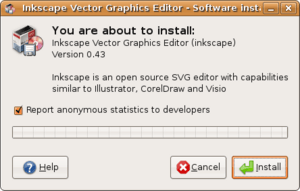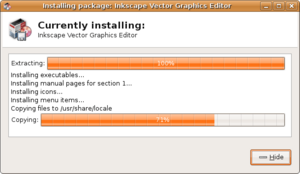Autopackage facts for kids
 |
|

Autopackage ready to install software on Ubuntu
|
|
| Original author(s) | Mike Hearn |
|---|---|
| Developer(s) | Jan Niklas Hasse |
| Initial release | Around 2002 |
| Stable release |
1.4.2 / May 24, 2009
|
| Written in | Bash, C, C++ and Python |
| Operating system | Linux |
| Type | Package management system |
| License | GNU Lesser General Public License |
Autopackage is a special computer program that helps you install other programs on Linux computers. It's like a universal installer! Mike Hearn created it around 2002. The goal was to make it super easy to put new software on any Linux system.
In August 2010, Autopackage joined forces with another project called Listaller. They decided to work together.
Some well-known programs, like aMSN and Inkscape, used to offer Autopackage installers. A website called Freecode also let people share links to Autopackage files. However, the list of programs available through Autopackage became quite small, and many of the program versions were very old.
Contents
How Autopackage Works
Autopackage was made for installing programs that aren't part of the main computer system. Think of apps like word processors, web browsers, or personal computer games. It wasn't meant for important system parts, like the core files that make your computer run.
Making Linux Better
The main idea behind Autopackage was to make Linux easier to use, especially for desktop computers. It aimed to create a stable way for programs to work, similar to how they do on Windows or macOS.
Working with Other Systems
Autopackage was designed to work alongside the regular ways Linux computers install software, like RPM or deb files. Instead of checking a list of installed programs, Autopackage would look directly for the files it needed. This made it simpler because it didn't have to know about every single way different Linux systems managed their software.
Installing Anywhere
Programs that use Autopackage must be "relocatable." This means they can be installed in different folders without breaking. Because of this, you could even install an Autopackage program in your own user folder, without needing special administrator permissions.
Autopackage Files
Autopackage files usually end with .package. They are actually special scripts that you can run to install the software. It's not easy to open these files with other tools because they have a unique way of organizing their contents.
Potential Conflicts
Sometimes, Autopackage programs might try to install files in the same place as programs installed by your computer's usual system. This could cause problems. Usually, you could fix this by removing an older version of a program before installing a new one with Autopackage.
Using Listaller
The Autopackage files can also be installed and removed using the Listaller tool. Listaller can include Autopackage files within its own system and manage them just like any other program.
See also
 In Spanish: Autopackage para niños
In Spanish: Autopackage para niños
- AppImage
- Flatpak
- Listaller
- Package management system
- Bundle (software distribution)
- Linux package formats
- List of software package management systems


